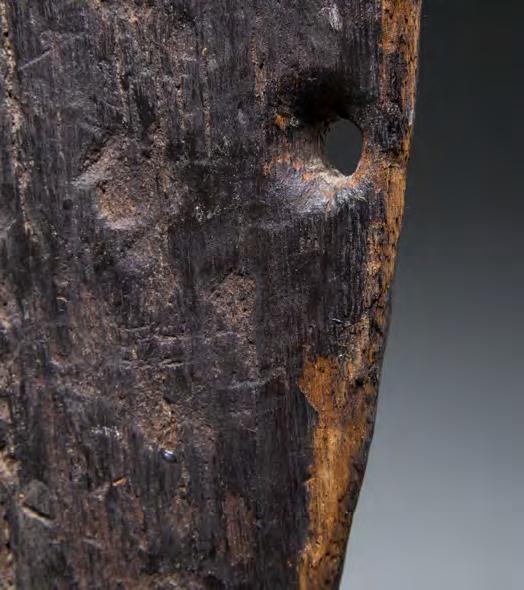
58 minute read
The Astrolabe Bay Area, 1870–1914. Collectors, Collections, Masks
Gábor Vargyas
Advertisement
In his paper on “Huon Gulf Collections and Collectors,” R. L. Welsch (2016:16) deplores that “The Huon Gulf is one of the areas on the mainland of Papua New Guinea that was contacted by Europeans earliest, and yet the region and its art are among the least-well-known of the major art-producing regions of New Guinea.” This statement applies just as well to another part of former German New Guinea, the Astrolabe Bay1. The Papuan villages and colonial settlements alike are mostly situated on the narrow littoral south from Madang (Friedrich-Wilhelmshafen), or on the offshore islands (Bilbil, Yabob), and a few other villages further inland.
Named after the corvette “Astrolabe” of Dumont d’Urville who put the area on the map in 1827, Astrolabe Bay was one of the earliest administrative centers of the German protectorate “Kaiser Wilhelmsland” created in 1884. After the abandonment of Finschhafen as the seat of the colonial administration in 1891, Stephansort—a commercial station and the first headquarters of the German New Guinea Company near Bogadjim village, founded in 1888—became the center of the administration for one year (1891–1892), before it was transferred to Friedrich-Wilhelmshafen (today: Madang), and finally to Herberthshöhe (today: Kokopo) in New Britain (1899).
Colonization went hand in hand with evangelization: the Astrolabe Bay was the territory of the Rhenish (Protestant) Mission Society2 that founded its first mission station in Bogadjim (1887), followed by a few others (1889 Siar, 1890 Karkar,3 1895 Bongu, 1901 Graget). By 1901 there were four coastal centers with four white missionaries and a school: Bogadjim, Siar, Bongu, and Graget; the first hinterland station (1906 Nobonob) and the true inland station at Amele (1916) were founded in the next decades. Notwithstanding the evangelizing efforts, the first baptism occurred only on December 28, 1903, in Bogadjim, and in 1907 “after twenty years of missionary activity the number of Christians totaled twenty-seven souls altogether” (Steffen 1995: 34, quoting Kriele 1927:130).4 The first conversion in mass occurred in 1914 in Bongu when 127 persons were baptized.
Figure 1
1 In geographical terms an approximately 50-55 km long coastline with its hinterland stretching from Cape Kusserow at Madang (formerly Friedrich-Wilhelmshafen) on the North-West to Cape Rigny on the South-East. Culturally speaking, however, the region extends further north another 45-50 kms up to Cape Croiselles on the mainland, including the “Archipelago of well-content people” (named by Miklouho-Maclay) off Madang, the Hansemann Mountains, Dampier/Karkar and Rich/Bagabag Islands; and south some 200 kms along the Maclay/Rai Coast through Saidor up to Cape König Wilhelm/King William near Sialum – a transitional zone to the Huon Gulf area (Bodrogi, 1959:97). 2 As opposed to the Huon Gulf area that became the hunting ground of the Neuendettelsauer (Lutheran) Mission Society one year earlier (Simbang, near Finschhafen 1886). 3 Karkar had to be interrupted in 1895 because of hostilities and a heavy volcanic eruption. Instead, Thiar/Siar’s subsidiary station and school (“Aussenstation mit Schule”) at Graget island was developed into an independent station. Karkar was re-opened in 1909. 4 Here and in the following all translations from German, Russian, French, and Hungarian are mine.
The first European to set foot in the Astrolabe Bay area was the Russian traveler-explorer, natural scientist-ethnographer, artist and humanist, Nikolai Nikolaevich Miklouho-Maclay (1846–1888).5 Beside extensive trips all over the Pacific and Indonesia, and shorter visits and stays at other parts of New Guinea (Triton Bay, Southeast Papua, etc.), Maclay spent nearly three years in the southern part of the Astrolabe Bay between 1871 and 18836 as an early precursor of stationary anthropological fieldwork. With this early date, he is not only one of the very first researchers in German New Guinea in general, but the only one to have worked in the Astrolabe Bay in the pre-contact period, before colonialization and pacification took place.
Unfortunately, apart from some scientific papers (Miklucho-Maclay 1875, 1876, 1878) he presented his data mostly in the traditional literary forms of his time, diary and travel report, not producing any ethnographic monograph—a fact that earned him later criticism (quoted in Tutorsky et al. 2019). A mythical figure nonetheless, an “archetype from the dreamtime of anthropology” (Stocking 1992), he was held in great esteem among his contemporaries. Otto Finsch praised him as follows: “I heard his name called as a friend from Cape Teliata to Karkar everywhere where we met Aboriginals, and whenever a Papaya tree (Carica), a gourd, a watermelon (Arbuse) was shown to us, it was named ‘Maclay’ because he had introduced these fruits here.” His writings “belong to the best of what has ever been written about Papuans. I may allow myself this judgement since I could check his reports on the spot and ascertain their accuracy, the completeness of which being possible at all only through such a long stay and innerly contact with the Aborigines” (Finsch 1893: 39–40 [177–178]).7
The German medical doctor Bernhard von Hagen published brief recollections of the Papuan inhabitants about Maclay (1903 in Russian)—a research line that was picked up later by Butinov (1950).8 From Australian anthropologist Peter Lawrence we know that Maclay’s name—in a transfigured form, as a cargo deity—was alive during his fieldwork in 1949 on the Rai (formerly Maclay) coast: “The Garia never saw him, for he never travelled very far inland, but his name and fame spread and were incorporated in local religions. In the 1960s he was even identified as Jesus Christ (Lawrence 1986:537).”
His small but substantial ethnographic collection of 198 objects (Mikluho-Maklaj 1886; Mikluho-Maklaj 2020/Vol.6/1; Ivanova, 2021) contains 70 pieces from the Astrolabe Bay, among them four “telum,” i.e., great male and female wooden statues, two human figures made of clay (called also “telum”), and a set of musical instruments connected with the local “Ai” (spirit) cult—but no masks. Among his approximately 740 drawings, however, there are three that depict masks (Mikluho-Maklaj 2020, Vol. 6/1:410—Figure 1) or masked dancers at a “masquerade” (Mikluho-Maklaj 2020, Vol.3:130 and Vol.6/1:414—Figure 2a,b)9. The first one, dated September 8, 1876, from Sangdimbi-Mana village, is obviously a rendering of the mask itself shown “in use” by the two other drawings. These two latter are clearly variants of each other, with Figure 2a probably being a draft and Figure 2b a final. Unfortunately, there is practically no information on the drawings.
5 His name is spelled in slightly different ways in different publications and languages: Miklucho-Maclay, Mikloucho-Maclay, Miklouho-Maclay, Mikluho-Maclay, etc., owing to the different transliterations of the original Russian Cyrillic alphabet. In this respect, in the bibliographical references I kept the original spellings for his German, Dutch, and French papers; for transliterating the Russian entries I have followed the English transliteration presently in use: Mikluho-Maklaj; and in the text I retained the widely used and accepted form “Maclay.” 6 First trip: September 1871–December 1872, a total of 15 months at Garagassi Point near Gumbu and Gorendu villages; second trip: June 1876–November 1877, a total of 17 months at Bugarlom Point, near Bongu village; third trip: February–March 1883: 3 weeks in the Astrolabe Bay. 7 Finsch 1893 has two sets of page numbers, I reproduce both. See also Finsch’s necrology of Maclay (Finsch 1888c). 8 In one of his notes, Hungarian researcher Lajos Biró (see later) mentions a story in connection with Maclay: at the end of his second stay, he offered some cows—bought at a colonial exhibition somewhere—to the inhabitants of Bongu village, that had become wild. Though they caused a lot of problem ruining and trampling down the village gardens, the inhabitants of Bongu did not want to kill them because they considered them “Maclay’s property.” When Finsch arrived in 1884, they implored him to “liberate them from the beasts” (Biró 1932:162–164). 9 Since all the drawings of Maklai in the 2020 second, enlarged and corrected version of his Collected Works are reproduced only in black and white, the colour pictures for the illustrations of this paper are taken from the older, 1954 edition.
It is not clear why the “draft” has a localization in its printed legend (Gumbu village)10 which is not visible on the drawing itself, while the other bears an original legend by Maclay: “Ai, Maclay coast” without localization. And, as we have seen, the sketch of the mask itself was made in Sangdimbi-Mana village. Also, the date of the making of both “masquerades” is unknown. Nonetheless their importance is unquestionable: because of a lack of contemporaneous photographs, they are the only known portrayals of a masked dancer from the Astrolabe Bay area!
As for the use of the masks, Maclay is very laconic, speaking mostly in general terms. On May 31, 1872, on his visit to Englam Mana village “in a special hut” where amongst others four telums were kept, he “was shown, with a great show of mystery and whispered talk, a large wooden mask with holes for the eyes and mouth which was worn during certain feasts; its name here is ain, and it was the first one that I had the chance to see” (Tumarkin 1982:231). In a letter to Prince A. A. Meshchersky about “Some results of my second stay at the Maclay Coast of New Guinea in the years of 1876–77,” written at Bugarlom point, October–November, 1877, he casually mentions in his description of Sambul Mana village two masks that he has seen: “Apart from two wooden masks used for the Ai-Mun [festival] […] I became attentive of some bones…” (Mikluho-Maklaj 2020, Vol.2:242).
His most detailed description is to be found in his “Ethnological Notes” (Miklucho-Maclay 1876): “In November and December, when Papuans happen to have less work on the plantations, other types of feasts are organized. One of them, where only men are admitted, is called Ai-mun; while another, held within the village, and at which women and children are allowed to participate, is known by the name Sel-mun. At an Ai-mun, specific masquerades take place. Newly painted aidogans (very tall wooden figures carved out of one [piece of] timber and having several [human] figures one above the other) that play an outstanding role in the masquerades, are carried to the place of the feast. The Ai-mun lasts some days during which men are especially excited. Day and night, without a stop, masquerades, eating, music, etc. follow each other. Somewhere it is the Ai-mun that plays an outstanding role, somewhere it is the Sel-mun. Sometimes the Ai wanders from one village to another. On such occasions a sham fight is fought between the invading Ai and the men of the Sel-mun. I was so much interested in these festivities that once I had almost no sleep during 3 days and 2 nights so that I could witness one of them” (1876: 332–333).
What is left out from this published paper is made up for in a draft (in Russian) for a lecture in November–December 1886 in Sankt Petersburg (Mikluho-Maklaj 2020, Vol.3:344–352),11 in which he lengthily details an Ai-mun festival with its dances, musical instruments, banquets, prescriptions, and taboos—but does not say one word on the masks! In short, it seems that Maclay had no deep experience with the masks—either because they were few and used only at rare occasions or because they were among the most tabooed religious objects to which he had but limited access.
The other iconic name insofar as Astrolab Bay is concerned, is the well-known naturalist, ethnographer, explorer, and pioneer of German colonialism, Otto Finsch (1839–1917). He led two great expeditions to the Pacific motivated by an early interest in New Guinea (Finsch 1865). The first South Sea Expedition (1879–1882), organized on his repute as an ornithologist, but dominated by his ethnological interests, was financed by the Humboldt Foundation in Berlin; it covered practically the wholePacific and took him to Hawai’i; the Marshall, Gilbert, and Caroline islands; Nauru; New Ireland; New Britain; Sydney; New Zealand; the Torres strait islands; Southeast-New Guinea; and Indonesia. It
10 Perhaps because an entry in Maclay’s diary, dated December 5, 1876 (Mikloucho-Maclay 1975:254) describing a Sel-Mun (a festive occasion with dance at which huge headdresses called sanguine-ole—but not the masks—are used. See Fig.3. in this paper) contains this placename in its heading: “Gumbu” in parenthesis. 11 Not yet translated and published in English.
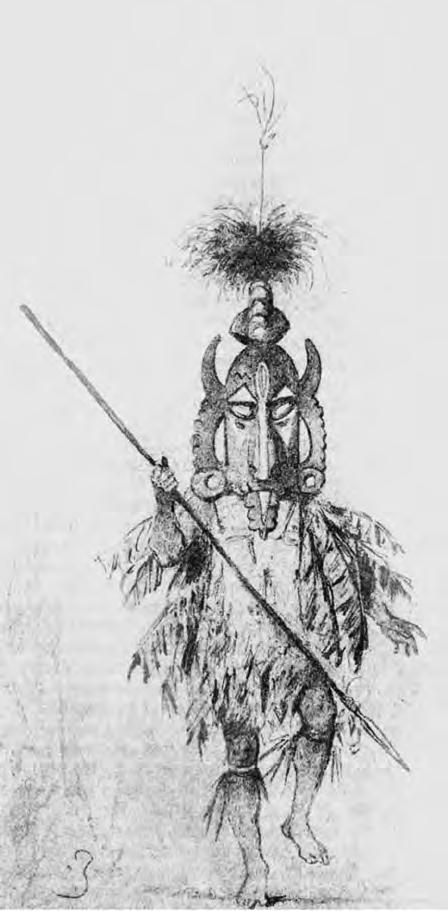
resulted in approximately 4,000 ethnological objects,12 not to speak of the natural-historical and anatomical collections, especially his 200 pieces of plaster-cast “masks,” i.e., casts taken from faces of living humans, of which he was especially fond (see Finsch 1884, 1899:14–15). His second expedition to the Pacific (1884–1885) on board the screw-steamer “Samoa,” “was financed and operated by a group of wealthy German traders, entrepreneurs, and businessmen with colonial interests in Northeast New Guinea and the Bismarck Archipelago” (Weiss – Cazan-Simányi 2012:60; see also Sack 1972). The expedition’s main task was to prepare the establishment of the future German Protectorate, to raise the flag, to look for harbors, and to make friendly contacts with the natives (Finsch 1899: 19; see also Weiss – Cazan-Simányi 2012:60, and Sack 1972). He met these requirements creditably and was instrumental in the acquisition of Kaiser-Wilhelmsland and the Bismarck Archipelago in 1884. The so-founded German New Guinea had a capital that was named Finschhafen in his honor, and, on his return, he was awarded with the Prussian medal. Nevertheless, contrary to his legitimate hopes, Finsch was not appointed as an administrator to the new territories, and he also failed to negotiate a privileged position for himself at the New Guinea Company for which he worked for two years as an advisor. Returning Figure 2a and 2b (lower right) to Bremen, he devoted the next ten years (1886–1896) to working with his collections, publishing scientific books, organizing exhibitions, and doing popularizing work.
The second expedition was made up of six exploratory trips along the entire north coast of New Guinea between East Cape and the Dutch border (Humboldt Bay). His first and only longer stay in the Astrolabe Bay took place October 7–29, 1884, on his first New Guinea trip. He arrived in Konstantinhafen, known from the description of Maklai, hoisted the German flag on 17 October, acquired some land, sailed to the north, discovered the bay of what became later Madang harbor (then: Friedrich-Wilhelmshafen) and the islands nearby (“the Archipelago of Well-Content People” and Prinz Heinrich-Hafen). On his return, he sailed till Festungspitze (Fortification Point), all along the Maclay Coast, and from there he followed the southern coast of New Britain up to Mioko (Finsch 1899:19–20).
12 Of these 4,000 objects, 1,665 pieces were retained for the Völkerkunde Museum in Berlin.
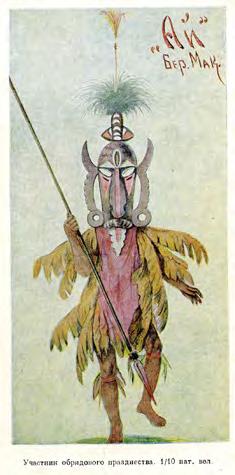
In addition to exploration and colonial politics, he had relatively little time to pursue scientific research. According to his own comment, “As leader of an expedition whose main task was acquisition of land that had nothing to do with ethnological research, I could devote to this latter only my free time […] trying to use it often in very hard circumstances” (Finsch 1893:40/178). Summing up his results a bit later, concerning collecting he adds: “As compared to my geographical results, the ethnological ones may perhaps be even more important, and they are of practical use for the aims of the Company. Convinced in the veracity of the above, I not only kept special notebooks on the Aborigines but labored—in hard circumstances and with self-devotion—on bringing together a rich and diverse ethnological collection, a task for which I was not bound by contract” (Finsch 1899:28–29). “As a visible result of my efforts, I brought back a very rich collection, the main part of which, 2,128 pieces—as from all my collections—went to the Royal Museum of Ethnology in Berlin through purchase from the New Guinea Company” (Finsch 1893:40/178)—with doublets or less important pieces getting into “provincial” museums.
On both Pacific expeditions, he had the right to collect or keep redundant pieces for his own purposes. He assembled thus a huge private collection that ended up later—divided and sold Figure 3
in parts—in what is today the Weltmuseum, Wien; the National Museum of Prehistory and Ethnography “Luigi Pigorini”; The Kunstkamera Peter the Great Museum of Anthropology and Ethnography, Russian Academy of Sciences; the Field Museum of Natural History, Chicago; and the American Museum of Natural History, New York (Finsch 1899:29; see also Howes 2018:4). As far as I know, there has never been an attempt to reunite—virtually, in an exhibition, or a publication—these collections, and apart from Ethnologische Erfahrungen (1893) that presents the collection in Vienna, and a “ready for print” manuscript catalogue written between 1892–1897 for the collection kept at the Natural History Museum in New York,13 there are no publications on Finsch’s museum material.
His other collections (in Berlin and elsewhere) are known only from old exhibition catalogues (Finsch 1886a, 1886b, 1887, 1892–1897), inaccessible for the time being. And since after his second expedition Finsch returned to Bremen and became only at the end of his career—after a detour at the Museum of Natural History, Leiden, as an ornithologist (1897–1904)—the curator of ethnology at the Municipal Museum in Braunschweig, a post he held until his death (1904–1917), it is not impossible that these museums also contain some smaller collections or objects from him.14
To come back to collecting, it “is far not as easy as it seems, especially not amongst Primitives (Naturvölkern) who do not work for trade and have no basaars. The expectations brought here from museums are satisfied only partially […] An even greater hardship than collecting itself is constituted by the inquiry after the use of the objects at many occasions. The great linguistic diversity especially

13 See his note in 1899:29 and 73. 14 In 2012 an exhibition at the “Weltmuseum” in Vienna was devoted to Finsch, “the passionate collector” and scientist. See Weiss and Cazan-Simányi 2012.
in Melanesia causes the foremost problem in this respect, whereby misunderstandings are so easy to commit” (Finsch 1893:86, quoted by Weiss – Cazan-Simányi 2012:16). This collecting, as pointed out by Welsch (2005:12), was typically “shipboard collecting.” “While Finsch and later explorers covered extensive distances and made significant collections of art and objects of ethnological interest, they typically made their collections aboard their ships. Villagers would swim or paddle their small canoes from their villages to the ships and barter with virtually everyone on board.” Let us face it, this is the easiest way of collecting and transporting the objects home. Why then Finsch complains repeatedly about “hard circumstances” and boasts of “self-devotion,” is not exactly clear.
Unfortunately, we know next to nothing on the circumstances of the acquisition of his pieces, but, in the best cases, the exact provenance of the object is known. His Astrolabe Bay objects are described in Finsch 1893:37/125–121/259. They mostly come from the area “around Konstantinhafen (Bongu village) and, a bit further to west, Bogadschi village where the New Guinea Company has founded a few years ago the test-station Stephansort” (1893: 181/43). Besides, Bilibili, “a small but densely populated and rich island in the northern part of the Astrolabe Bay” and Gráger (Graget/Kranket) island are mentioned as where pieces in his collection may originate. Regrettably, in their description Finsch often lumps together the whole north coast from Huon Gulf to the Sepik mouth, accepting the generally held opinion of his time (Haddon 1894; Preuss 1897–98).
For the description of the masks, e.g., he repeats Maclay’s note on the Ai festivals while presenting two “beak-style” masks from the Dallmannhafen (Wewak) area and a small stone telum from Bongu (Plate XXIII. page 146/360)—giving the false impression of speaking about one and the same thing, the Astrolabe Bay-style province.
I left to the end an intriguing question concerning Finsch’s personal acquaintance with Miclouho-Maclay. Writing about the Ai-mun festivals and the masquerades/masks connected with them (reproduced faithfully after Maclay’s description), he mentions en passant “Maclay showed me among his sketches the phantastic tower-like headdresses made of feathers, colored leaves and similar things that men wear on their head” (1893:255/117). Figure 3. The question arises immediately: where and when did they meet? Nothing is known about it. Surely, it could not be in New Guinea. Maclay stayed three times in the Astrolabe Bay, in 1871–1872, 1876–1877, and 1883. Finsch, however, visited the region first in October 1884. As both scientists travelled a lot, not only in Europe but all over the world, they must have met each other somewhere else. The most likely place is Australia: between June 1883 and February 1886, Maclay lived in Sydney15 and Finsch set out for his second Pacific expedition from the same place, having spent three months in Sydney from 15 June to 10 September 1884. They may have used this opportunity to meet, if, for nothing else, courtesy, sharing information or consultation and advice. Another intriguing question is why Finsch speaks only about the drawing of the tower-like headdresses when describing the masked processions? Did he not know drawings Figs. 1 and 2ab reproduced above? Why is he silent about them? Did he not see them? Unfortunately, the casual passage does not allow us more than formulating the question.
Let us close this excursus on Finsch’s activity with a lesson that may sound astounding: in his published oeuvre of several thousand pages just as in his museological material totaling again several thousand pieces16 , there is not one picture of a mask from the Astrolabe Bay or one mention of a piece collected or seen by him. His eventual discussion of the masks is admittedly a paraphrase of the
15 For Maklai’s detailed CV with exact dates, see Mikluho-Maklaj 2020, Vol.1:23–28. (In Russian). 16 Approximately 4,000 pieces from his first Pacific expedition plus 2,128 objects in Berlin from the second expedition plus his private collections sold abroad not to speak of his pieces in “provincial” German museums. All this adds up to likely 7-8000 pieces.
description of Maclay with whom he was acquainted. In sum: the single month he spent in Astrolabe Bay was not enough for him to do deep collecting, and masks do not figure in his collection.17 All this points again to the fact that masks were rare and hardly accessible objects for collectors even in the early pre-contact period. In any event, Finsch’s report and testimony are of inestimable value: after Maclay, he is the first to furnish data on the material and spiritual culture of the Astrolabe Bay area.
Our next protagonists are two Hungarians, Samuel Fenichel (1868–1893) and Lajos Biró (1856–1931), both natural historians by training turned into ethnographers as it was common at the beginnings of ethnography/anthropology.18 Both stayed and worked in the same decade, the 1890s in the Astrolabe Bay. Fenichel was the first (December 22, 1891–March 6,1893) and when he died of blackwater fever in Stephansort after 15 months of active collecting, Biró took up the relay baton and stayed for six years in German New Guinea (January 1, 1896–December 27, 1901)—a significant part of which was spent in the Astrolabe Bay.
The context of their stay and collecting was practically the same. In 1896, Hungary celebrated the 1000-year anniversary of the foundation of the Hungarian Kingdom, a member state of the Austro-Hungarian Monarchy. This period between 186719 and 1918 was the Golden Age in Hungarian history, the palmy days of peace in every aspect, political, economic, and cultural alike. The dynamic atmosphere coupled with national pride brought with it a heightened emphasis on scientific inquiry, amongst others ethnography/anthropology and social evolution. In contrast to the great colonial powers like England, France, or Germany, Hungary has never had colonies and thus did not have the opportunity to do research on “exotic” places and cultures in her own territories/colonies. Her only prospect in this regard stemmed from her association with the German Empire through the Austrian side of the Austrian-Hungarian Monarchy, a relationship that concluded with the dissolution of the Monarchy at the close of World War I. But here, we are still in the heydays of the Dual Monarchy, and the newly acquired German colony, New Guinea, was a par excellence place for discovering a hitherto unknown exotic flora and fauna or doing evolutionist research among “living stone-age” people— thus working for the benefit of humankind.20
Since the life and activity of both Fenichel and Biró has been summed up in English (Vargyas 2008; see also Gyarmati 2008) and has been discussed from several aspects (Bodrogi 1953, 1959, 1978–1980, 1979, 1982, 1990; Vargyas 1986, 1987, 1991, 1998, 2016), I will touch on the essential. Fenichel, an amateur archaeologist and ornithologist, coming from a multi-lingual Transylvanian milieu and employed as a taxidermist-curator at the Department of Archaeology, National Museum of Bucharest, arrived in German New Guinea as a member of an ornithological expedition organized and financed by German naturalist, ethnologist, traveler, photographer, and undertaker, Alfred Grubauer (1869–1960).21 Their expedition shipwrecked in the first days of their arrival in New Guinea, and Fenichel found himself left behind without financial support and backing. Thus, he turned to the Hungarian National Museum and offered his services.
17 This statement may turn out later to be wrong as his collections from the Astrolabe Bay are not yet processed and published. 18 Maclay and Finsch were also natural historians, Maclay—amongst others—a marine biologist, and Finsch an ornithologist. 19 1867: year of the “Compromise” and creation of the Austro-Hungarian Monarchy that ceased to exist after World War I. 20 See e.g., the letter of Lajos Biró, written in Madang, November 18, 1899 (Biró 1923:157): “Nothing could make me happier than if some day in the future one could report that though Finschhafen had been almost for a decade the center of gravity of German colonization, a point of departure of any scientific expedition, and yet we Hungarians discovered it for science!” 21 Grubauer undertook later several expeditions to insular Southeast Asia hunting for ethnographic items (“curios”) to sell them to museums in Europe. In 1911, he was active in British North Borneo. See Kasatkina, Alexandra (2018–2019): A “Missing Link?” A set of genital piercing instruments from British North Borneo in the collections of Albert Grubauer in St. Petersburg and Munich. Journal Fünf Kontinente Vol.3: 195–218. See also his Unter Kopfjägern in Central-Celebes. Ethnologische Streifzüge in Südost- und Central-Celebes. Leipzig: R. Voigtländers Verlag, 1913.
According to an agreement concluded with museum leadership, from then on, Fenichel would collect artefacts for the Museum,22 and the museum would transfer payment to New Guinea. Due to the circumstances, he settled down in Bongu village and, stepping into Maclay’s shoes, became an unwitting pioneer of stationary fieldwork. It is clear from his correspondence that sharing the life of the inhabitants of Bongu enabled him to learn the local language within few months; he was thus able to continue his work. Eventually, his interests came to include ethnography as well as natural history. Before his death in Stephansort on March 6, 1893, Fenichel assembled an outstanding collection of ethnographic objects (around 2,600 pieces, and 30 photographs), soon to be united with the Lajos Bíró Collection to form the backbone of the Museum of Ethnography’s Pacific Collections and, within it, the internationally famous Astrolabe Bay Collection.
His bequest reached Hungary via Berlin through J. S. Kubary,23 then stationmaster in Konstantinhafen (now Erimba, south of Madang), who handled it ex officio. Fenichel’s collection is unparalleled both for its size and in that it represents the earliest phase of the contact period when local cultures had had only limited and recent contact with the outside world, and when the most impressive religious art objects could still be obtained. Unfortunately, his early death prevented him from completing his lifework. The artefacts and the masks he collected entered the museum devoid of documentation (similarly to nearly all the great collections of the period), and his life remains a tragic loss.
Fenichel’s death came as a shock to scientific circles in Hungary, and the Zoology Department of the Hungarian Academy of Sciences expressed the need that his work be continued. It was Lajos Biró, a natural historian of country-wide fame, who took up the thread. The two men conducted their work on similar terms. Just as had Fenichel, Bíró worked in association with the National Museum in Budapest. He sent artefacts to the Department of Ethnography which culled out what it needed, estimated the value of the items concerned, and transferred payment to New Guinea. The leftover pieces remained as the property of Biró who had free disposal of them—an arrangement similar to that of Finsch.
Biró’s collections were partly published in bilingual catalogues (Hungarian and German) while he was still in the field in New Guinea (Biró 1899, 1901). The museum staff catalogued the artefacts according to type, wrote the introductory and chapter notes together with the bibliographic references, while Biró’s personal notes appeared in parentheses. These publications earned him worldwide fame even if he was unhappy with the abovementioned solution. Knowing from his own experience how much the published data was unreliable, he warned his colleagues about the uncritical use of the scientific literature of his time. This may be the reason why the second part of his Astrolabe Bay collection, just like the one from the Huon Gulf, has never been published. And, to the great detriment of ethnology and Pacific studies, Biró has never published his oft-promised magnum opus on the cultures of Astrolabe Bay and the other places he had visited. The elaboration of his material remained a lifetime occupation for the next generations.

22 At that time, the National Museum housed ethnographic collections, too, in its Department of Ethnography. The Museum of Ethnography became formally independent only in 1947. 23 J. S. Kubary (1946–1896) is known for his classic works on the Caroline Islands, Micronesia.
Biró’s fame has cast a shadow over Fenichel whose name is often unjustly omitted or neglected. This is not only because he spent much longer in New Guinea than his predecessor, and collected twice as many objects, or because he survived and had time to work on his fame. It ensues mostly from his great achievement and true novelty: Biró not only collected but also documented the collected objects in a most meticulous way. In this respect he surpasses by far all his contemporaries24 and later collectors. For each object, he recorded how, when, and where it was produced, how it was used, and what local names applied, including the names of any motifs involved. It was Bíró who first understood that the place of acquisition is not necessarily the place of manufacture, and it was Bíró who first called attention to the widespread use of barter in the region.
Bíró also discovered the principle by which some areas served as places of manufacture and others as places of use. He gave ethnographic objects the same attention an entomologist gives his moths and insects, striving to collect entire series of artefacts to document the variety of decorative motifs and the differences introduced by individual artisans. Even so, his collection of around 5,500 pieces falls short of Fenichel’s in several respects, especially in art pieces associated with religious practices (masks, telums, dance rattles, ritual carvings, etc.), probably as a consequence of a rapid culture change in the coastal areas.
For reasons not yet clear, culture change in the Astrolabe Bay region has been extremely early and swift, and many traditional objects or object types disappeared entirely in a few years’ time. Whether this could be the result of evangelization is a question. We had seen the lack of success of this latter in the introductory part: the first baptism occurred only December 28, 1903, in Bogadjim (two years after Biró’s departure in 1901 and ten years after Fenichel’s death) and even in 1907 “after twenty years of missionary activity the number of Christians totaled twenty-seven souls altogether” (Steffen 1995: 34). This could suggest that the influence of Christianity is negligible as far as our period is concerned. The relatively dense chain of mission stations on a tight coastal area not exceeding 50 kms in length,25 however, suggests an implicit impact on the surrounding population well before conversion took place. If not, Christian evangelizers nonetheless were agents of a new way of life and values and perhaps eventual “curio-hunters?” I repeat the year of the foundation of the mission stations: 1887 Bogadjim; 1889 Siar; 1890 Karkar (with an interruption between 1895–1909); 1895 Bongu; 1901 Graget. One wonders if the existence of these early mission stations and the disappearance of religious artworks in the same period cannot be connected.
In this respect a telling example, first mentioned and analyzed by Bodrogi (1953:91–92), is that seven of the eight telum figures or ancestral statues currently found in the New Guinea collection were contributed by Fenichel. Bíró, who conducted his own and most thorough collecting work not more than three years after Fenichel, managed to acquire only one complete statue and one fragment. What is more, the Museum owns sixteen (!) masks26 from the Astrolabe Bay from Fenichel’s collection, a number probably surpassing all the other existing ones taken together from all over the world. In sharp contrast with it, Biró’s collection does not contain either a mask or a note on this type of object, notwithstanding the fact that Biró lived for a longer time in the Astrolabe Bay than Fenichel and that he exceeded him in every respect as a collector. All this points unequivocally to the fact that by 1895–1896, the date of Biró’s relatively early arrival to the Astrolabe Bay, there were no showy “art pieces” available for collectors—whether it was due to the impact of evangelization or something else.

24 See Finsch’s complaints about the difficulties of getting information on the objects, above, p.?. 25 From south to north in the Astrolabe Bay: Bongu, Bogadjim, Siar, and Graged. 26 In the meantime, three of them have been exchanged. See later.
Certainly, German presence and colonialization must have played a key role in it. The fact that the headquarters of the colony were for one year in Stephansort near Bogadjim (1891–1892), then for another seven years in Madang (1892–1899), surely meant a quick intrusion, a close everyday contact, and a heavy European influence in the area. The rapid economic development, the orderly communication with the outside world (regular passenger ships and mailboats to Singapore, Batavia, and Sydney), the hustle and bustle in the new industrial undertakings and plantations of the New Guinea Company, the scientific expeditions led into the hinterland (Schrader 1886, Zöller 1888, Lauterbach 1890, Ehlers 1895, Tappenbeck 1896, etc.) opened up the region with tremendous speed.27 To read Biró’s popularizing writings and look at his photos, one has the impression that the German administrators in New Guinea did not lack for anything—be it home comfort, social club, ice-cold beer, or nice-looking handmaids.28All this coupled with the presence of warships in the harbors of Konstantinhafen and Madang, the police forces, the acquaintance of the local population with firearms, and especially the most unfortunate first retaliating expeditions must have triggered a pronounced and quick culture change.29
A third possible reason for the disappearance of ethnographica, especially the spectacular art pieces must have been “curio-hunting.” There is no place to dwell lengthily here on the question. Be it enough that from the establishment of German rule onwards (1884), it was strictly regulated and controlled but still omnipresent. “From 1884 to 1899, the New Guinea Company administered the German colony solely for its own financial gain […] Company policies allowed staff to collect ethnological material wherever they went as a sideline and supplementary source of company revenues. In principle these items were to be turned over to company administrators, who then sold them to curio dealers in Germany” (Welsch 2005:14). Collecting was taxed. For example, Biró’s yearly incomes were estimated to 4,000 German marks: “I am fortunate that the Tax Assessment Committee considered me a collector for the Museum, therefore I was not charged [as much] as if I would have collected for commercial reasons. […] Paradise-bird hunting is taxed with a supertax: it coasts yearly 1,000 marks” (Biró 1923: 34).
Curios were held in great esteem, so much that “snatching away ethnologica is a fashionable entertainment hereabouts and if ever something human would happen to me, [my collection] will be lost forever” (Biró 1932: 137). Several of Biró’s photos show his verandah or the interior of his house: it is jampacked with ethnographic objects arranged as in a museum. Furthermore, an established custom in social communication in German New Guinea was reciprocating a service, a loan, or some help “through a gift of stuffed bird, butterfly or ethnologica” (Biró 1932:71). In sum, collecting in the early contact period was one of the most popular pastimes. The situation reminds one of the ironic comment of A. B. Lewis from 1912 from Papua: “The white population is estimated at about 1,000, and nearly every man is, or has been, on the lookout for “curios’” (Welsch 2005:13).
All in all, notwithstanding Biró’s self-confident assertion “the first day of 1896 when I landed in New Guinea, I arrived in a virgin region free of European influence. Wherever I went, arriving at the thirdfourth village, lots of Aboriginals came to see me because I was the first European they had met” (Biró 1932:154), we cannot be overly wrong if by the years of 1895–1896 we suppose tentatively a first wave of culture change, i.e., the intrusion of European goods and as a consequence, the exhaustion of the traditional material culture. The first decade of German rule seems to have resulted in “emptying” the region of its traditional material culture, mostly religious art objects.
27 By 1901, the New Guinea Company established a narrow-gage railway towed by oxen in Stephansort. 28 For the everyday life of the colonial administration in the Astrolabe Bay, see Vargyas 1986:12–40. 29 For an eyewitness description of Biró on a retaliation on French Islands, February 18, 1901 by the warship “Cormoran” see Vargyas 1986:54–77 and Plates 64–66.
Let us stop here for a moment to have a closer look at the masks from Fenichel’s collection. We had seen that the sixteen pieces collected by him represent a uniquely rich collection even in a worldwide comparison: their number, I repeat, surpasses in all probability all the other existing ones taken together from all over the world. No other collection, no other museum in the world owns more than one or two pieces altogether, and even if the exact number of existing Astrolabe Bay masks has not yet been established, it is highly unlikely that the sum total will ever reach over thirty. Owing to the early death of Fenichel, the masks are unfortunately not accompanied by notes. All we know about them, and their use, has been summarized by Tibor Bodrogi in two papers (1953, 1959). The first (1953) is an exceptionally detailed summary of all the literary sources relating to the initiation rituals and circumcision in the Astrolabe Bay area and, together with it, a short general summary of the masks (p.133) which is followed by a list and picture of all the Fenichel masks in the collections of the Ethnographic Museum (pp.151–168) plus a selection of other artifacts used during the same initiations rituals, from the collections of Fenichel and Biró and again in the Museum of Ethnography (pp. 168–184).
As for the formal traits of the masks, Bodrogi’s description is more than succinct: “The masks are anthropomorphic, hatchet-faced, and their craftmanship is rather rough and rude. On their backs, which are done with somewhat less care, the traces of carving are clearly seen. Every mask has features entirely of its own. On each of them there are spy-holes30 under the eyes that are usually carved bas relief” (Bodrogi 1953:133).
A second and somewhat more detailed description is given by him in his second publication: “The few masks from the Astrolabe Bay which are in European collections belong undoubtedly to the most splendid works of New Guinea art […]. Though rather crude and clumsy, they represent the figures they want to personify, presumably the ancestors, with a convincing force. There are not two identical masks among those we know and yet, the elements of their design make it evident that all of them belong to the same style province: this is quite clear from those characteristics which they have in common with the sculptures. The wooden masks are either elongated rectangles or ovals. The plastically carved circular or oval eyes are surmounted by the protruding supraorbital ridges. Eyebrows are indicated by curved lines. On the upper part of the masks, we frequently encounter the flattened hemisphere indicative of the shaggy headdress. The ears are executed with to open-work technique— the same as on statues—and adorned with carved earrings. Large, sharply curved noses constitute a characteristic feature. Unlike large statues, masks are provided with oral apertures, and the teeth in the mouth are indicated by notches. We have found the hanging martial mouth-projection, so characteristic of larger statues, only on two of the masks known to us” (Bodrogi 1959:59).
ASTROLABE BAY MASKS IN MUSEUM OF ETHNOGRAPHY, BUDAPEST 1-No 8918, 45 cm, purplish brown color. 2-No 8919, 43 cm, purplish brown color. 3-No 8920. Black, on the face in place traces of red paint, 45 cm. Published by Bodrogi 1959: Plate number 31 [with a mistaken register number]). Exchanged in 1971. Today in the JOLIKA collection of John and Marcia Friede, housed at the “de Young Museum”, Fine Arts Museums of San Francisco. See New Guinea Art 2005: Plates 366a, b. 4-No.8921, 43 cm, purple color.
30 “Spy holes” are real holes for the dancers to see since the “eyes” of the masks are carved in relief, without a hole. See the drawing of Maclay (Fig.1.) where an abbreviated explanation in Russian is added in front of this hole: “otverstye dlja glaza” = “hole for the eyes.”
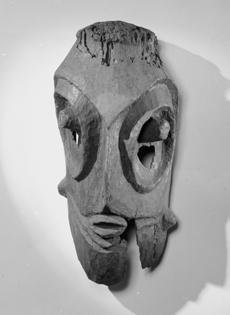
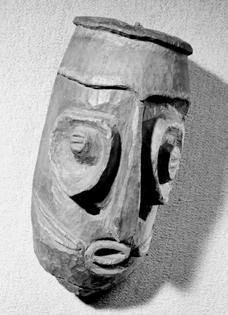
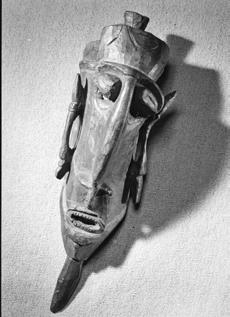
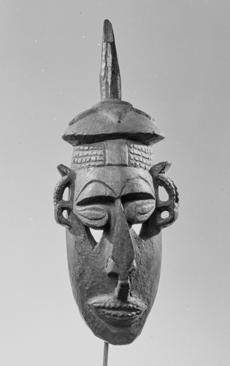
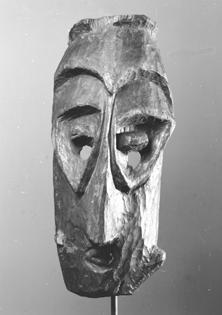
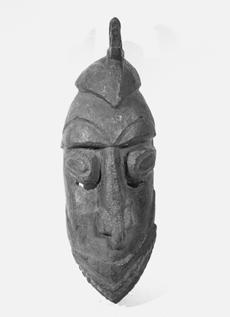
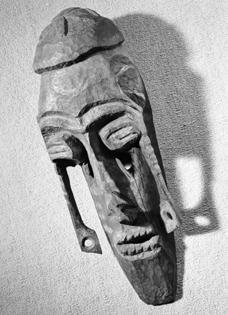
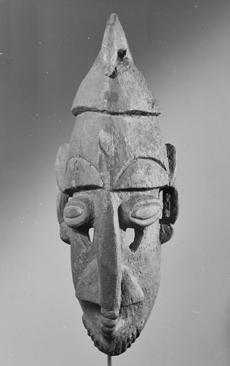
Astrolabe Bay Masks in the Museum of Ethnography, Budapest.

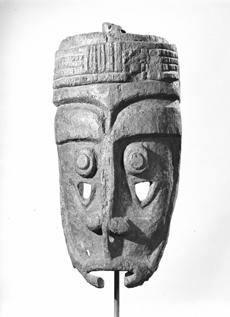
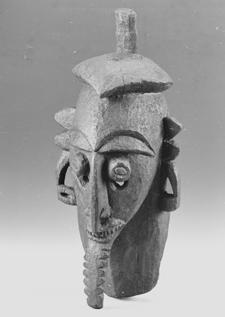


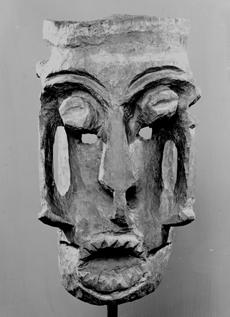

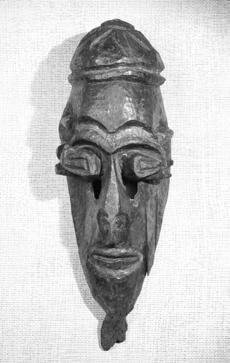
5-No 8922, 69 cm, dark brown and glossy color. Exchanged in 1962 with the “Museum der Kulturen” (then: Museum für Völkerkunde) in Basel. 6-No 8923. The headdress represents three wild boar tusks bent into a circle, 57 cm, dark brown color. 7-No 8924, 49 cm, dark brown color. 8-No 8925, 42 cm, greyish brown with purple shades color. 9-No 8926, 60 cm, blackish color. 10-No 9827, 48 cm, purple brown color. Exchanged in 1962 with the “Museum der Kulturen” (then:
Museum für Völkerkunde) in Basel. 11-No 8928, 60 cm, blackish brown color. 12-No 8929 A very old piece, cracked in places, 39 cm, color dark brown, in places with purple and black paint. 13-No 8930, 39 cm, purplish brown in color. 14-No 8931. Half of the face is painted black, the other half red, around the labial parts the color is white, 40 cm 15-No 8932.66 cm, purplish in color, glossy surface. 16-No 8933. Blackish, the labial parts are framed white, on the face stripes of white, 53 cm.
Continuing with the history of collecting in the Astrolabe Bay, the last major figure in the pre-World War I period is Albert Buell Lewis (1867–1940), “the first American anthropologist to conduct systematic research” in Melanesia and New Guinea (Welsch 1999:4). The lifework of Lewis and the history of the Joseph N. Field South Pacific Expedition in 1909-191331 has been treated in detail in a remarkable two-volume book by R. Welsch (1998). As a former PhD student of Boas and newly appointed assistant curator in 1909, Lewis was sent by the Field Museum in Chicago—then an emerging new museum competing for fame with older, more established institutions in the USA—to collect ethnological artifacts. The trip that lasted for four years took him all over Melanesia, all the colonial territories of Melanesia: Fiji, New Caledonia, the New Hebrides, the Solomon Islands, German New Guinea, Papua, and Dutch New Guinea. At the end of his trip, he “assembled the largest single collection of Melanesian material culture ever made in the field. Containing more than fourteen thousand objects and nearly two thousand photographs, this collection is still the premier American collection from Melanesia. It remains one of the most important research and reference collections of Melanesian material culture in the world” (Welsch 1998:3).
Lewis arrived in the Astrolabe Bay April 5, 1910 and left it June 4 for the North Coast. By then, the region has undergone a rapid culture change. He did not linger for too long. He visited Madang town a few times and made a few cursory comments on what he saw. Thus, an entry in his diary dated April 12, 1910, from a trip to Panim village, four hours of walk inland from Madang, runs as follows: “Bought a few things. Not much here. Pots from Bilibili. Also a few from the interior, thin coiled ware. Got 4 of these. Bowls (wood) from Rai coast; a few old shields, and spears, ornaments not many (compared to islands), and a tendency to mix in beads. Saw one dance mask or headdress, shaped like a house, with a long pole on top, covered with feathers and cloth. The house was of painted bark, also paper and cloth, so that it was of no worth. Had been made for the Christmas dances” (Welsch 1998:224). Another entry describes the situation at Graget island off Madang where he made a visit guided by the missionary of the Rhenish Mission Society, Heinrich Helmich. Here, in the men’s house,
31 Named so in honor of the patron and financial backer of the expedition, Joseph N. Field.
he saw “bows (from inland), arrows (from inland and Rai—also fish arrows homemade), spears (native and from inland), 21 shield, 1 broken figure (post?) with snake and frog, and feet of human image broken off. Canoe with one sideboard very rudely ornamented. End piece bent […] and ornamented” (Welsch 1998: 236).
The mention of the remains of a broken human figure (probably a telum) in the men’s house on Graget island epitomizes the general situation in the Astrolabe Bay: the “classical” places, Bogadjim, Bongu, Bilbil, Siar, Graget, etc., to the south from Madang had been well picked-over by 1910 by one visitor after another. These communities “were among the most profoundly influenced by contact with Germans. These villages had been evangelized by the Lutherans; large tracts of their lands had been alienated by the company; and they were being administered harshly by German kiaps […] To prevent all the village land from being transformed into New Guinea Compagnie plantations, the administration had even been forced to establish reserves or reservations around Friedrich-Wilhelmshafen” (Welsch 1998:228).
Thus, having bought some few things of the small handicraft sort, he moved further along the coast to the north. His plan was to link places he had known from his earlier visits (Huon Gulf, Aitape region, etc.), setting off from Madang both in western and eastern directions so that he would have a complete picture of the cultural variations of a huge area—a question that was the focus of his interest as a researcher. Most of the 2,854 objects originating from the “North Coast” are not from the Astrolabe Bay region; they came from the coastline and its immediate hinterland north of Madang up to the Ramu and the Sepik mouth. The objects are poorly attributed, the total number that have an exact place of origin from Astrolabe Bay proper hardly reach 150, Rai coast included. To sum up: “Lewis may have collected a few ornaments of no significance from Astrolabe Bay, but no carvings of any significance”32 —not to speak of masks which he does not mention at all. Rai coast is for that matter a question: we know that Lewis planned to visit it, but it is not clear if he ever made it. There is no mention of it in the surviving documents.33 As for photographs, of the surviving 1,561 images hardly two dozen were shot in the Astrolabe Bay.
We cannot but lament this situation because Lewis was an excellent fieldworker and collector. “He kept a daily journal or expedition diary that outlined his activities and what he observed in the villages. In this field diary Lewis kept notes about how different objects were made or used, jotted down other information about material culture, and entered remarks and observations that provoked his interest. As he moved about the region he kept a systematic log of his collection, a list of numbered specimens with notes about each piece (usually indicating where a piece was collected and made), local names, and other notes as appropriate. These specimen lists, together with his field diary and other notes, provided information about specific pieces and were the notes he used to catalog the collection on his return. By today’s standards the documentation of his collection is limited to be sure, but his documentation is general much better than that of other researchers and collectors of his day” (Welsch 1998:9).
With Lewis, we arrive to the end of our panorama of the great collectors and collections from Astrolabe Bay. Certainly, many people—German and other administrators, officials, servicemen, missionaries, medical doctors, traders, undertakers, explorers, and scientists—had lived and worked for shorter or longer periods in the region. Most of them probably did some collecting and acquired eventually important items, but their collections, if they ever existed as such, are unknown for the
32 Personal communication of Robert Welsch to Gábor Vargyas July 22, 2021, mediated by Michael Hamson. 33 See Note 6. page 585. of Book 4. in Vol.1.
time. A detailed inventory of existing Astrolabe Bay collections is still wanting. Smaller, unknown collections emerge from time to time (Melk-Koch 2007). A few extraordinary pieces had been published in the past. To close this paper, I wish to present a few masks known from little-known old publications without pretension to fullness.
As far as I know, the only Astrolabe Bay mask pictured in an early, end of nineteenth-century publication is due to medical doctor Bernhard von Hagen, founding director of the Museum of Ethnology in Frankfurt (1904), after his return from the Astrolabe Bay where he had served as doctor of the New Guinea Company in Stephansort from 1893 to 1895. Hagen and Biró knew each other, and, according to this latter’s opinion, his book is one of the few reliable publications on the Astrolabe Bay region. “Unter den Papuas in Deutsch-Neu-Guinea,” published in 1899, contains a photo (Plate 27) which shows “Implements and Arms from German New Guinea” arranged on a wall “artistically,” and among them a beautiful wooden mask, with the following legend on its backside: “Wooden Asa-mask from Bogadjim village.” Figure 4 This photo is doubly important: it is the only one that shows a mask in situ, in the Astrolabe Bay, in the possession of its owner, Dr. Hagen. Second, it authenticates the provenance from Bogadjim village—a rare fact as most of the early pieces are labelled in contemporary museum collections “German New Guinea” or, in the best of the cases, “Astrolabe Bay.” Moreover, this mask belongs Figure 4 today to the Pacific collections of the Linden Museum, Stuttgart (No.27,128; Bogadjim). When and how this mask got to the Linden museum’s collections is not known; it is not known either if Hagen had had a collection apart from this one mask.
Another relatively early publication is the 1929 Volume (No. 2–3.) of the journal “Cahiers d’Art.”34 It contains a curious paper by an anonymous author, a certain “Dr. O.” on “primitive art and psychoanalysis according to Eckard von Sydow.” Among the 45 illustrations that have hardly any legends and that have nothing to do with the text having been chosen probably for the sake of “nice” illustrations, nos. 39, 40, and 41 are pictures of unique masks from the Astrolabe Bay. Two of them, nos. 39 and 40, are labelled belonging to the “Museum in Barmen.” This must be the Archive und Museum of the “United Evangelical Mission”35 in Wuppertal today. It is not known if the pieces still exist, and I do not know of any publication from the Museum that would contain a newer picture of them. Figure 5
The story of the third piece Fig. 41. is even more interesting: it belonged to the “Flechtheim collection.” Alfred Flechtheim (1878–1937) was a German art dealer of Jewish origin, specialized mostly in modern French and German art, expelled by the Nazis in 1933. His collection, part of the “degenerate art,” was confiscated and sold. Part of it reached the USA later. What this piece may have become is not known. If there is a hope for the masks in Barmen to have survived, the Flechtheim piece is probably lost forever.
In sum, we have seen the main protagonists on the Astrolabe Bay scene before the First World War: Maclay, the Russian; Finsch, the German; Fenichel and Bíró, the Hungarians; and Lewis, the American. Among them, only the two Hungarians have succeeded in assembling a collection unique both from quantitative and qualitative points of views. Maclay’s collection from the Astrolabe Bay is
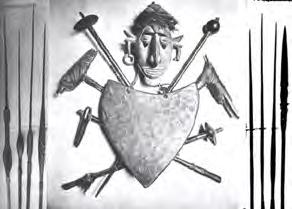
34 “Cahiers d’Art” is/was a French artistic and literary journal founded in 1926 by art critic Christian Zervos that existed until 1960. Since 2012 it is newly published. It was also a publishing house that edited monographs on French artists of the first half of the 20st century. Third, it was a modern art gallery, too. 35 The VEM (“Vereinigte Evangelische Mission” [United Evangelical Mission]) is a fusion since 1971 of the Rhenish Mission Society founded in 1818 and the Bethel Mission founded in 1886. In 1979 the Zaire mission also joined them. The VEM has an Archive and Museum, named “Museum auf der Hardt” in Wuppertal-Barmen. Barmen was an independent city until 1929 when it was united to Wuppertal.
small (70 pieces altogether) but fundamental. Finsch’s collections (6,000–8,000 objects?) do not seem to have especially important Astrolabe Bay pieces. Fenichel’s smaller but earlier collection (around 2,600 objects) is unsurpassable insofar it contains most of the splendid religious art works, masks (as ancestral figures [telums], dance rattles, stone figures, etc.) that we know at present. As for the first ones, probably more than half of the known existing masks in the world from the Astrolabe Bay were collected by him. Biró’s greater collection (5,500 pieces) does not have any masks and contains few ancestral figures and no dance rattles. Finally, Lewis’ huge collection (of 14,000 objects) is insignificant insofar as Astrolabe Bay is concerned. It follows that the only important collection in the world (over 8,000 pieces!) representing the material culture of the Astrolabe Bay in its totality, not to speak of the masterpieces of the region’s art and among them, the masks, collected in the early contact period (1891–1893 for Fenichel and 1896-1901 for Biró), is to be found in Hungary, in the Museum of Ethnography, Budapest. As far as masks are concerned I cannot but repeat what I had said twentytwo years ago: “I would like to draw attention to the fact how small is the number of existing masks and telums. In his 1959 paper Bodrogi catalogued forty-six telums and twenty-six masks altogether (in both cases museum objects, field photos and drawings included!). Even if we assume unrealistically that future research will double their number, we shall still count them in tens and not in hundreds or thousands—not to speak about the abundance of Sepik or New Ireland art pieces! This means that Astrolabe Bay objects may count amongst the rarest pieces of Papua New Guinea art and as such, they are of inestimable value. Time has come to take detailed inventories of them and to present them in a publication for the scientific world and the descendants of their makers” (Vargyas 1999:252).

Figure 5
BIBLIOGRAPHY Anonym: [Dr. O. monogram] (1929): Art primitif et psychanalyse d’après Eckart von Sydow. Cahier d’Art, 1929. 2-3: 65–72. Apelt, Wolfgang (compiled by) (2016): Die Rheinische Mission/The
Rhenish Mission, 1828–1970. Findhilfe/Finding aid. Wuppertal. Biró, Lajos (ed. by Jankó, János) (1899): Beschreibender Catalog der ethnographischen Sammlung Ludwig Biró-s aus Deutsch-Neu-
Guinea (Berlinhafen). Budapest. Biró, Lajos (ed. by Seemayer, Villibald) (1901): Beschreibender
Catalog der ethnographischen Sammlung Ludwig Biró-s aus
Deutsch-Neu-Guinea (Astrolabe-Bai). Budapest. Biró, Lajos (1923): Hét év Új-Guineában. Levelek két világrészb l. [Seven years in New Guinea. Letters from two continents. In
Hungarian.] Budapest: Világirodalom. Biró, Lajos (1932): Újguineai utazásom emlékei [Memories of my
Travels in New Guinea. In Hungarian] Budapest: Királyi Magyar
Természettudományi Társulat. Bodrogi, Tibor (1953): Some Notes on the Ethnography of New
Guinea. I. Initiation Rites and Ghost-Cult in the Astrolabe Bay
Region. Acta Ethnographica, III: 91–144. Bodrogi, Tibor (1959): New Guinean Style Provinces. The Style
Province “Astrolabe Bay.” In T. Bodrogi and L. Boglár (eds.) (): Opuscula Ethnologica Memoriae Ludovici Bíró Sacra. Bp.
Akadémiai K., 39–99. Bodrogi, Tibor (1978-80): A Mask from the Astrolabe Bay Area. The
Minneapolis Institute of Arts Bulletin, LXIV: 80–87. Bodrogi, Tibor (1979): Style Provinces and Trading Areas in North and Northeast New Guinea. In S. Mead (ed.): Exploring the
Visual Art of Oceania. The University Press of Hawaii, Honolulu, 265–277. Bodrogi, Tibor (1982): M vészet Észak-Új-Guineában, az Astrolabeöböl térségében. [Art in Northeast New Guinea, in the Astrolabe
Bay Area] M vészet, Vol. XXIII. Nr. 10. 39–43. Bodrogi, Tibor (1990): Between the Invisible and the Tangible. The
Role of Art in Communication Between the Two Realms. An
Example from Papua New Guinea. In D. Eban (ed.): Art as a
Means of Communication in Pre-Literate Societies. The Israel
Museum, Jerusalem, 7–26. Buschmann, Rainer F. (2009): Anthropology’s Global Histories: The
Ethnographic Frontier in German New Guinea. 1870–1935.
Honolulu: University of Hawaii Press. Butinov, N.A. (1950): Vospominaniya papuasov o Miklukho-Maklaye po svidetelstvam pozdneishikh puteshestvennikov. [Recollections of the Papuans of Miklucho-Maclay according to the testimony of later travelers.] In: Miklucho-Maclay, N.N. (1951–1954):
Sobranie sochinenij. Vol II.: 739–750. Czapli ka, Maria Antonina (1914): Life and Work of N. N. Miklukho-
Maklay. (Abstract and translation by Czapli ka.) Man, No.98. 198–203. Gyarmati, János (ed.by) (2008): Taking them back to my homeland…
Hungarian Collectors – Non-European Collections of the Museum of Ethnography in a European Context. Budapest: Museum of
Ethnography. Finsch, Otto (1865): Neu-Guinea und Seine Bewohner. Bremen: C.E.
Müller. Finsch, Otto (1884): Anthropologische Ergebnisse einer Reise in die Südsee und den malayischen Archipel in den Jahren 1879–1882. Beschreibender Catalog der auf dieser Reise gesammelten Gesichtsmasken von Völkertypen, herausgegeben mit Unterstützung der Berliner Anthropologischen Gesellschaft, mit einem Vorwort von Prof. Rudolf Virchow. Zeitschrift für
Ethnologie. Organ der Berliner Gesellschaft für Anthropologie,
Ethnologie, und Urgeschichte 15. Supplement. Finsch, Otto (1886a) Katalog der ethnologischen Sammlung der
Neu-Guinea-Compagnie, ausgestellt im königl. Museum für
Völkerkunde (Berlin 1886), I. S. 7–27; II. S. 7–38. Megkérve
Krisztinától Finsch, Otto (1886b) Die ethnologische Ausstellung der Neu-Guinea-
Compagnie im königl. Museum für Völkerkunde. In: Original-
Mittheilungen aus der ethnologischen Abtheilung des königl.
Museums zu Berlin. Herausgegen von der Verwaltung. Jahrg. 1. (1886), Heft 2/3 S.92–101. Megkérve Krisztinától Finsch, Otto (1887) Katalog der Ausstellung für vergleichende
Völkerkunde des westlichen Südsee, besonders der deutschen
Schutzgebiete. Mit Erläuterungen von Dr. O. Finsch (Bremen 1887, 26 S. 8o) Megkérve Krisztinától Finsch, Otto (1888a): Samoa-Fahrten. Reisen in Kaiser Wilhelms-
Land und Englisch-Neu-Guinea in den Jahren 1884 und 1885 an
Bord des Deutschen Dampfers “Samoa.” Leipzig, Ferdinand Hirt & Sohn. Finsch, Otto (1888b): Ethnologischer Atlas. Typen aus der Steinzeit.
Samoafahrten von Dr. O. Finsch. Leipzig: Ferdinand Hirt & Sohn. (háromnyelv ! német+angol+francia) Finsch, Otto (1888c): „Nicolaus v. Miklucho-Maclay, Reisen und
Wirken.” Deutsche geographische Blätter (Bremen), 270–309. megkérve Dimától Finsch, Otto (1892–1897) Beschreibender Catalog einer ethnologischen Sammlung aus der westlichen Südsee. With 71
Plates, 487 Figures. Manuscript, ready for press, written between 1892-1897. Finsch, Otto (1893): Ethnologische Erfahrungen und Belegstücke aus der Südsee. Beschreibender Katalog einer Sammlung in k. k. Naturhistorischen Museum in Wien. Annalen des k. k.
Naturhistorischen Hofmuseums in Wien III–VIII, 1888–1893.
Wien: Alfred Hölder. Finsch, Otto (1899): Systematische Übersicht der Ergebnisse seiner
Resien und schriftstellerischen Thätigkeit (1859–1899). Berlin: R.
Fiedländer & Sohn. Finsch, Otto (1914): Südseearbeiten. Gewerbe- und Kunstfleiss,
Tauschmittel und “Geld” der Eingeborenen auf Grundlage der
Rohstoffe und der geographischen Verbreitung. Hamburg: L.
Friedrichsen & Co. Haddon, Alfred C. (1894): The Decorative Art of British New Guinea.
Cunningham Memoirs No.10. Dublin. Hagen, Bernhard von (1899): Unter den Papuas in Deutsch-Neu-
Guinea. Wiesbaden. Hagen, Bernhard von (1903): Vospominaniya o N. N. Miklukho-
Maklaye u zhiteley zaliva Astrolyabiya na Novoy Gvineye. [The memory of Maklai among the inhabitants of Astrolabe Bay]
Zemlevedeniye, bk. 2/3: 245–252. megkérve Dimától Hamson, Michael (2016) (ed.): Between the Known and the
Unknown. New Guinea Art from Astrolabe Bay to Morobe.
Printed by Cassochrome, Waregem, Belgium. Howes, Hilary (2018): A “Perceptive Observer” in the Pacific: Life and Work of Otto Finsch. Bérose – Encyclopédie international des histoires de l’anhtropolgie. Paris, Bérose : article1468.html Ivanova L.A. (2021): tnograficheskoe sobranie N.N. Mikluho-
Maklaja. Materialy i issledovanija po istochnikovedeniju i atribucii. [Ethnographic Collections of N. N. Mikluho-Maklai. Materials and Studies on Source History and Attribution. In Russian] (Serija
«Kunstkamera—Arhiv». VIII) Sankt-Peterburg: MA RAN. Kriele, Eduard (1927) Das Kreuz unter den Palmen. Die Rheinische
Mission in Neu-Guinea. Barmen. Kunze, Georg (1897): Allerlei Bilder aus dem Leben der Papua.
Rheinische Missionsschriften, H. 3. Barmen. Lauterbach, Carl (1891): Eine Expedition zur Erforschung des
Hinterlandes der Astrolabe-Bai. Nachrichten über Kaiser-Wihelms-
Land. Vol. VII: 31–62. Berlin. Lawrence, Peter (1964): Road Belong Cargo. A study of the Cargo
Movement in the Southern Madang District New Guinea.
University of Manchester: University Press – Melbourne University
Press. Lawrence, Peter (1986) Review of Webster, E.M. “The Moon Man.”
Journal of the Polynesian Society, Volume 95 (No. 4): 537–542. Melk-Koch, Marion (2007): Wie die Südsee nach Thüringen kam …
Ethnographika aus dem Pazifik und aus Australien in Thüringen.
Mitteilungen der Anthropologischen Gesellschaft in Wien. Band 136/137: 203–224. Miklucho-Maclay, N.N. (1875) Ethnologische Bemerkungen ueber die Papuas der Maclay-Küste in Neu-Guinea. NTN, Deel. XXXV: 66–94. Miklucho-Maclay, N.N. (1876): Ethnologische Bemerkungen ueber die Papuas der Maclay-Küste in Neu-Guinea. NTN, Deel. XXXVI: 294–334.
Miklucho-Maclay, N. N. (1878): Vestiges de l’art chez les Papouas de la côte Maclay en Nouvelle-Guinée. Bulletin de la Société d’Anthropologie de Paris. Vol. III/1: 524–531. Mikluho-Maklaj, Nikolaj Nikolaevich (1886). Katalog predmetov tnologicheskoj kollekcii : S os-v Tihogo okeana. Sankt-Peterburg : tip. gaz. “Novosti” Mikluho-Maklaj, Nikolaj Nikolaevich (1951–1954): Sobranie sochinenij [Collected Works. In Russian] Tom I-V. Akademija nauk
CCCp. Moscow-Leningrad. Mikluho-Maklaj, Nikolaj Nikolaevich (2020): Sobranie sochinenij v shesti tomah. Vtoroe izdanie. Ispravlennoe i dopolnennoe. [Collected works in 6 Volumes. 2nd, enlarged and corrected edition.] (Tom.1. Puteshestvija 1870–1874 gg. Dnevniki, putevye zametki, otchety.; Tom.2. Puteshestvija 1874–1887 gg.
Dnevniki, putevye zametki, otchety.; Tom.3. Stat’i i materialy po antropologii i etnografii narodov Okeanii.; Tom.4. Stat’i i materialy po antropologii i etnografii Jugo-Vostochnoj Azii i Avstralii. Stat’i po estestvennym naukam.; Tom.5. Pis’ma.
Dokumenty i materialy.; Tom. 6. Vol. 1. Etnograficheskie kollekcii.
Risunki.; Tom.6. Vol. 2. Ukazateli) Sankt-Peterburg: 2020 Mikloucho-Maclay, N. N. (1975): New Guinea Diaries, 1871–1883. (Translated from the Russian with biographical and historical notes by C. L. Sentinella.) Kristen Press, Madang, Papua New
Guinea. Miklouho-Maclay, N. (1982): Travels to New Guinea. Diaries. Letters.
Documents. (Compiled, with a foreword and commentary by
Tumarkin, D.) Moscow: Progress Publishers. Mikluho-Maklaj-mladshij, N. N. (2020): “Po sledam Mikluho-
Maklaja”: rossijskie nauchnye ekspedicii na bereg Maklaja v XXI v. [“In the footsteps of Maclay”: Russian scientific expeditions to the Maclay coast in the 21st century.] In: Sobranie sochinenij v shesti tomah Vol.1.: I–XVI. Neuhauss, Richard (1911): Deutsch-Neu-Guinea. Vols. I–III. Berlin. New Guinea Art. Masterpieces from the Jolika Collection of Marcia and John Friede (2005). Essays by Gregory Hodgins, Philippe
Peltier, Dirk Smidt, and Robert L. Welsch. Vols.1-2. Fine Arts
Museums of San Francisco in Association with 5 Continents
Editions. Ohff, Hans Jürgen (2015): Disastrous Ventures. German and British
Enterprises in East New Guinea up to 1914. Plenum Publishing
Australia Preuss, Konrad Theodor (1897-98): Künstlerische Darstellungen aus
Kaiser-Wilhelms-Land in ihrer Bedeutung für die Ethnographie.
Zeitschrift für Ethnologie, Vol. XXIX:77–141 and Vol. XXX: 74–125. Sack, Peter G. (1972): Finsch, Otto (1839–1917). In Australian
Dictionary of Biography, vol.4. Carlton: Melbourne University
Press. https://adb.anu.edu.au/biography/finsch-otto-3519 Schmeltz, J. D. E. (1895–1896): Beiträge zur Ethnographie von
Neu-Guinea. V. Ueber eine Sammlung aus Konstantinhafen,
Astrolabebai. IAfE. Vol. VIII:241–244 és Vol. IX.:113–125. Steffen, Paul [B.] (1995): Missionsbeginn in Neuguinea. Die Anfänge der Rheinischen, Neuendettelsauer und Steyler Missionarbeit in
Neuguinea. (Studia Instituti Missiologici SVD 61.) Steyler Verlag,
Nettetal. Stocking, G. (1992): Maclay, Kubary, Malinowski: Archetypes from the dreamtime of anthropology. In The Ethnographer’s Magic and Other Essays in the History of Anthropology. Madison: Univ. of Wisconsin Press, pp. 212–275. Tappenbeck, Ernst (1901): Deutsch-Neuguinea. Berlin. Tokarev, Sz. A. (ed. in chief) (1975): Na beregu Maklaja.
Etnograficheskie Ocherki. Redakcionnaja kollegija: Tokarev S.A.,
Butinov N.A., Tumarkin D.D. Moskva: Izdatel’stvo “Nauka.” (Vtoroj vypusk) Tumarkin, D. D. (2011): The White Papuan: N.N. Miklouho-Maclay on the Background of his Era. Moscow, Vostochnaya Literatura. Tutorsky, A. V., E V. Govor and C. Ballard (2019): Miklouho-Maclay’s
Legacy in Russian- and English-Language Academic Research, 1992–2017. Archaeology, Ethnology and Anthropology of
Eurasia, 47/2:112–121. Vargyas, Gábor (1986): Data on the Pictorial History of Northeast
Papua New Guinea. (Occasional Papers in Anthropology 1.) Budapest, Ethnographical Institute of the Hungarian Academy of
Sciences, 1986, 90 pp. and 69 b/w photos. Vargyas, Gábor (1987): Field Notes from the Astrolabe Bay (Madang Province, Papua New Guinea). (Occasional Papers in Anthropology 2.) Budapest, Ethnographical Institute of the
Hungarian Academy of Sciences, 1987, 60 pp. and 195 b/w photos. Vargyas, Gábor (1991): “Bíró, Lajos.” In: International Dictionary of
Anthropologists. Compiled by Library-Anthropology Resource
Group. General Editor: Christopher Winters. Garland Publishing,
New York and London, 61–62. Vargyas, Gábor (1998): Art of the Astrolabe Bay. History of Research,
Results and Future Research Tasks. In Barry Craig – B. Kernot – and Christian Anderson (eds.): Art and Performance in Oceania.
Bathurst, Crawford House Publishing, 246–253. Vargyas, Gábor (2008): The Oceanian Collection. In: J. Gyarmati (ed. by): Taking them back to my homeland... Hungarian Collectors – Non-European Collections of the Museum of Ethnography in a
European Context. Budapest, Museum of Ethnography, 207–248. Vargyas, Gábor (2016): Through Each Other’s Eyes. How the
Hungarian Naturalist Lajos Biró saw German Missionaries in New
Guinea, and Vice Versa. In M. Hamson (ed.): Between the Known and the Unknown. New Guinea Art from Astrolabe Bay to
Morobe. Printed by Cassochrome, Waregem, Belgium, 32–37. Webster, Elsie May (1984): The Moon Man: A Biography of Nikolai
Miklouho-Maclay. Berkeley and Los Angeles: University of
California Press. Weiss, Gabriele und Ildikó Cazan-Simányi (2012): Aus dem Pazifik.
Ein Sammler aus Leidenschaft. F.H. Otto Finsch (1839-1917).
Eine Ausstellung des Museums für Völkerkunde, Wien –
Kunsthistorisches Museum. Museum für Völkerkunde, Wien, 16.
Mai bis 8. Oktober, 2012. Welsch, Robert L. (ed.): (1998): An American Anthropologist in
Melanesia: A. B. Lewis and the Josph N. Field South Pacific
Expedition, 1909–1913. Honolulu: University of Hawai’i Press. (2 vols.) Welsch, Robert L. (2000): One time, one place, three collections: colonial processes and the shaping of some museum collections from German New Guinea. In Hunting the Gatherers:
Ethnographic Collectors, Agents and Agency in Melanesia, 1870s–1930s. Eds. by Michael O’Hanlon and R. L. Welsch.
Oxford: Berghahn Books, 55–79. Welsch, Robert L. (2005): One symphony from many voices: collectors, collecting activities, and the culture of collecting Since 1870. In New Guinea Art. Masterpieces from the Jolika Collection of Marcia and John Friede. Pp.8–29. Welsch, Robert L. (2016): Huon Gulf Collections and Collectors: on Understanding the Art of the Huon Peninsula and the Vitiaz
Strait. In Hamson, Michael (2016) (ed.): Between the Known and the Unknown. New Guinea Art from Astrolabe Bay to Morobe.
Printed by Cassochrome, Waregem, Belgium, pp. 16–21. Werner, E. (1911): Kaiser-Wilhelms-Land. Beobachtungen und
Erlebnisse in den Urwäldern Neuguinea. Freiburg. Wichmann, Artur (1909–1912): Entdeckungsgeschichte von
Neu-Guinea. 1909: vol.1: Entdeckungsgeschichte von Neu-
Guinea bis 1828, 45 maps, 387 pp.; 1910: vol. 2. (1st part):
Entdeckungsgeschichte von Neu-Guinea 1828–1885, 37 maps, 369 pp.; 1912: Entdeckungsgeschichte von Neu-Guinea 1885–1902, 36 maps, 1026 pp. Leiden, Brill. Zöller, Hugo (1891): Deutsch-Neu-Guinea und meine Ersteigung des
Finisterre-Gebirges. Stuttgart–Berlin–Leipzig.
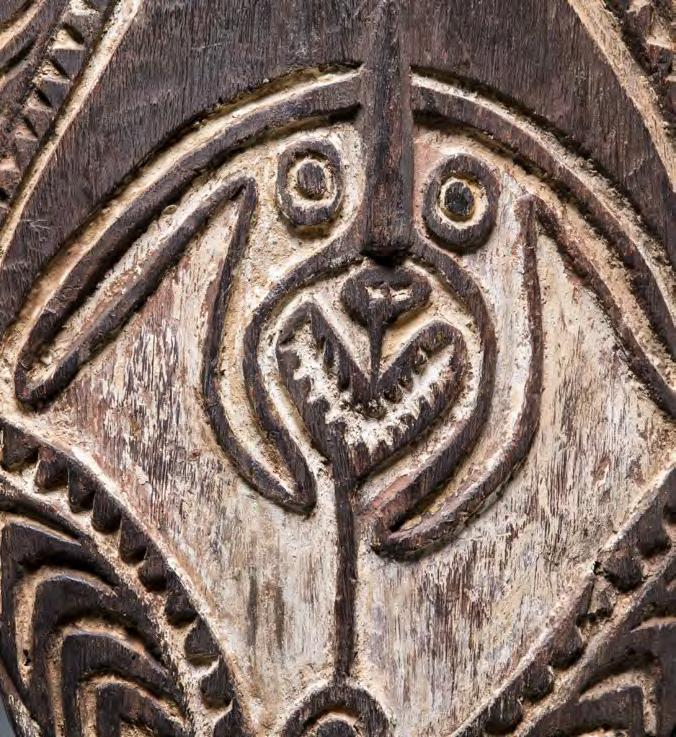
19 Papuan Gulf Spirit Board, Kwoi
Purari Delta region, Gulf Province, Papua New Guinea Gaston de Havenon Collection, New York Pre-contact, stone-carved, 19th century 47¾” (121.2 cm) in height
There is a weight, scale, and presence to this spirit board that is undeniably ancient. The design is essentially symmetrical but swerves and undulates as is typical in precontact, stone-carved objects. Age, clarity, expression, bold graphics, and a distinguished provenance set this one at the very top of the category.
